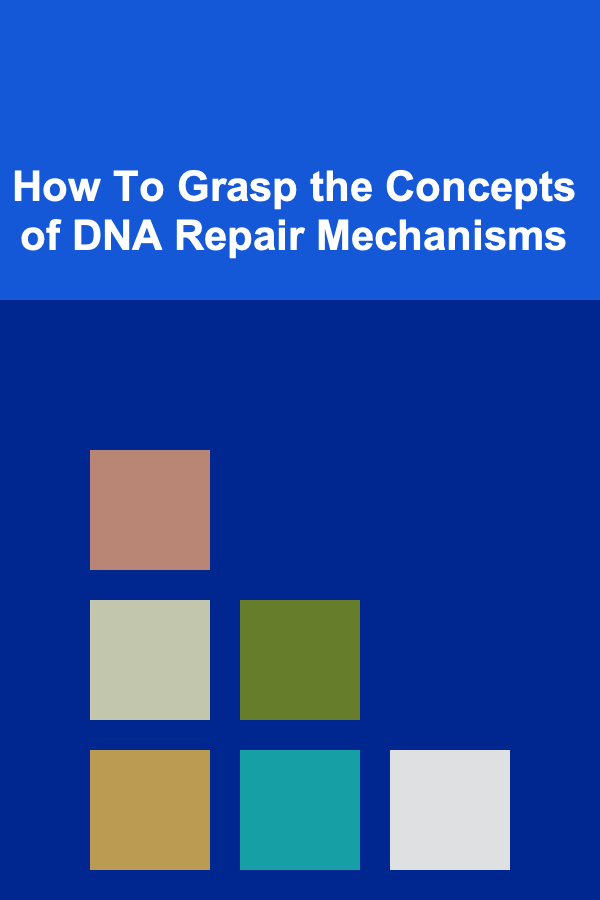
How To Grasp the Concepts of DNA Repair Mechanisms
ebook include PDF & Audio bundle (Micro Guide)
$12.99$5.99
Limited Time Offer! Order within the next:

DNA repair mechanisms are essential for maintaining genomic stability, ensuring proper cell function, and preventing diseases such as cancer. The DNA molecule, which carries genetic information, is constantly exposed to a variety of internal and external stresses, including radiation, chemical agents, and cellular metabolic processes. These stresses can lead to damage in the DNA, such as mutations or breaks in the DNA strands. Without efficient repair mechanisms, such damage can accumulate and contribute to the onset of diseases.
Understanding DNA repair mechanisms is a complex task, given the variety of repair pathways and their interactions. However, with a methodical approach, one can break down the concepts and gain a comprehensive understanding of how these repair mechanisms function. This article delves into the key aspects of DNA repair mechanisms, offering insights into the different types of DNA damage, the various repair mechanisms, and the importance of these processes in cellular function and disease prevention.
The Importance of DNA Repair Mechanisms
DNA is the fundamental material that carries genetic instructions for the development, functioning, and reproduction of living organisms. It is composed of two long strands of nucleotides twisted into a double helix structure. Each nucleotide consists of a sugar molecule, a phosphate group, and a nitrogenous base. There are four nitrogenous bases: adenine (A), thymine (T), cytosine (C), and guanine (G). The bases pair up in specific combinations, with adenine pairing with thymine, and cytosine pairing with guanine.
DNA is subjected to numerous sources of damage during its lifetime. These damages include base modifications, single-strand breaks (SSBs), double-strand breaks (DSBs), and the incorporation of incorrect bases during DNA replication. If left uncorrected, such damages can lead to mutations, genomic instability, and a variety of diseases, including cancer. Thus, DNA repair mechanisms are vital for maintaining cellular integrity, genetic diversity, and the overall health of an organism.
The repair mechanisms operate through several highly efficient systems, each tailored to address specific types of DNA damage. These mechanisms function in a highly coordinated manner, ensuring that the integrity of the genome is preserved.
Types of DNA Damage
DNA damage can occur due to both endogenous and exogenous factors. Endogenous factors include cellular processes such as replication, transcription, and oxidative stress. Exogenous factors, on the other hand, include environmental influences such as UV radiation, ionizing radiation, and chemical pollutants. The most common types of DNA damage are:
2.1 Single-Strand Breaks (SSBs)
Single-strand breaks occur when one of the two strands of the DNA helix is cleaved. This damage is generally less severe than double-strand breaks but can still lead to problems during DNA replication and transcription if left unrepaired. SSBs can be caused by oxidative stress, chemicals, and radiation.
2.2 Double-Strand Breaks (DSBs)
Double-strand breaks are considered one of the most lethal types of DNA damage, as they involve breaks in both strands of the DNA helix. DSBs can result in the complete loss of genetic information if not properly repaired. They are commonly induced by ionizing radiation and certain chemical agents.
2.3 Base Modifications and Mismatches
Base modifications involve the alteration of nitrogenous bases in the DNA, which can lead to incorrect base pairing during DNA replication. These modifications can arise from oxidative damage or chemical mutagens. Mismatches can occur during DNA replication when incorrect bases are incorporated into the newly synthesized strand.
2.4 Interstrand Crosslinks (ICLs)
Interstrand crosslinks are covalent bonds that form between the two strands of the DNA helix, preventing the strands from unwinding and separating. These crosslinks are often caused by exposure to certain chemotherapeutic drugs or environmental pollutants.
2.5 DNA Crosslinks
DNA crosslinks occur when two nucleotides from opposite strands of the DNA become covalently bonded. This can prevent proper DNA replication and transcription. Crosslinking agents are typically found in chemotherapy drugs, which use this mechanism to inhibit the growth of cancer cells.
2.6 Thymine Dimers
Thymine dimers form when two adjacent thymine bases on the same DNA strand bond together due to exposure to ultraviolet (UV) radiation. These dimers distort the DNA helix and can block DNA replication, leading to mutations if not repaired.
DNA Repair Pathways
Cells employ a variety of DNA repair mechanisms to correct different types of DNA damage. These mechanisms can be broadly categorized into the following pathways:
3.1 Direct Repair Mechanisms
Direct repair mechanisms involve the direct reversal of damage to the DNA without the need for excision or resynthesis of the damaged strand. These mechanisms are often used to repair specific types of damage, such as base modifications.
3.1.1 Photoreactivation
Photoreactivation is a direct repair mechanism that specifically targets thymine dimers caused by UV radiation. The enzyme photolyase absorbs light energy and uses it to break the covalent bonds between the thymine bases, restoring the DNA to its original state.
3.1.2 O6-Methylguanine-DNA Methyltransferase (MGMT)
MGMT is an enzyme that repairs alkylated DNA. When alkyl groups are added to the O6 position of guanine, MGMT removes the alkyl group and restores the normal base structure. This repair mechanism prevents mutations caused by alkylating agents.
3.2 Base Excision Repair (BER)
Base excision repair (BER) is a mechanism that repairs small, non-helix-distorting base lesions caused by oxidative damage, alkylation, or deamination. BER involves the removal of the damaged base by a DNA glycosylase, followed by the excision of the sugar-phosphate backbone. The resulting gap is filled by DNA polymerase, and the strand is sealed by DNA ligase.
3.2.1 DNA Glycosylases
DNA glycosylases are enzymes that recognize and remove damaged bases. Each glycosylase is specific to a particular type of damage, such as uracil or 8-oxoguanine, which can arise from oxidative damage.
3.3 Nucleotide Excision Repair (NER)
Nucleotide excision repair (NER) is responsible for repairing bulky DNA lesions, such as thymine dimers caused by UV radiation or chemical adducts. NER involves the recognition of the lesion by a protein complex, followed by the excision of a segment of the damaged strand. DNA polymerase then synthesizes a new segment, and the strand is sealed by ligase.
3.3.1 Global Genome NER (GG-NER) and Transcription-Coupled NER (TC-NER)
NER can be divided into two subtypes: global genome NER and transcription-coupled NER. GG-NER is responsible for scanning the entire genome for DNA lesions, while TC-NER specifically targets regions of the genome that are actively transcribed.
3.4 Mismatch Repair (MMR)
Mismatch repair (MMR) corrects errors that arise during DNA replication, such as base mismatches and small insertion-deletion loops. MMR involves the recognition of mismatched bases by specific proteins, the excision of the erroneous section, and the resynthesis of the correct sequence.
3.5 Double-Strand Break Repair
Double-strand breaks (DSBs) are the most dangerous form of DNA damage and require specialized repair mechanisms. There are two main pathways for repairing DSBs:
3.5.1 Non-Homologous End Joining (NHEJ)
Non-homologous end joining (NHEJ) is the primary repair pathway for DSBs in mammalian cells. NHEJ involves the direct ligation of the broken DNA ends without the need for a homologous template. Although efficient, NHEJ is error-prone and can lead to mutations or deletions at the repair site.
3.5.2 Homologous Recombination (HR)
Homologous recombination (HR) is a more accurate repair mechanism that uses a homologous template, usually the sister chromatid, to repair DSBs. HR is primarily active during the S and G2 phases of the cell cycle when a sister chromatid is available for repair. HR ensures accurate repair, but it is slower than NHEJ.
3.6 Translesion Synthesis (TLS)
Translesion synthesis (TLS) is a mechanism that allows DNA replication to proceed past damaged sites by using specialized DNA polymerases. These polymerases are able to replicate across damaged DNA, although they are more error-prone than the normal DNA polymerases.
The Role of DNA Repair in Disease Prevention
Proper DNA repair is crucial for preventing the accumulation of mutations that can lead to cancer, neurodegenerative diseases, and other conditions. Defects in DNA repair mechanisms are often associated with increased cancer risk, as cells with defective repair systems are more likely to accumulate mutations.
4.1 Cancer
Mutations in DNA repair genes are a common feature of many types of cancer. For example, mutations in the BRCA1 and BRCA2 genes, which are involved in homologous recombination repair, increase the risk of breast and ovarian cancers. Similarly, defects in mismatch repair genes are associated with Lynch syndrome, a hereditary condition that predisposes individuals to colorectal and other cancers.
4.2 Neurodegenerative Diseases
Inadequate DNA repair can also contribute to neurodegenerative diseases. For instance, defects in DNA repair mechanisms can lead to the accumulation of DNA damage in neurons, contributing to diseases such as Alzheimer's and Parkinson's.
4.3 Aging
The accumulation of DNA damage over time is a hallmark of aging. As cells age, their ability to repair DNA becomes less efficient, leading to the gradual accumulation of mutations. This accumulation of genetic damage is thought to contribute to the aging process and age-related diseases.
Conclusion
Grasping the concepts of DNA repair mechanisms requires an understanding of the various types of DNA damage and the sophisticated systems that cells use to repair such damage. DNA repair is critical for maintaining genomic stability, preventing diseases, and promoting cellular health. With ongoing research, our understanding of DNA repair mechanisms continues to evolve, offering promising avenues for the treatment of diseases associated with defective DNA repair. By appreciating the intricacies of these repair pathways, one can gain a deeper understanding of how cells maintain their integrity and how disruptions in these pathways can lead to disease.

How to Clean Your Toaster for Safety
Read More
How to Establish a Nightly Routine for Morning Success
Read More
How to Sell Rare Video Games on Online Marketplaces: An Actionable Guide
Read More
How to Use Vertical Space to Reduce Clutter
Read More
How To Date Successfully in the Modern World: A Comprehensive Guide
Read More
Feng Shui for New Beginnings: Moving into a New Home
Read MoreOther Products

How to Clean Your Toaster for Safety
Read More
How to Establish a Nightly Routine for Morning Success
Read More
How to Sell Rare Video Games on Online Marketplaces: An Actionable Guide
Read More
How to Use Vertical Space to Reduce Clutter
Read More
How To Date Successfully in the Modern World: A Comprehensive Guide
Read More